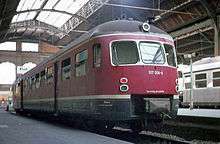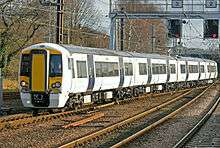Battery electric multiple unit

A battery electric multiple unit, battery electric railcar or accumulator railcar is an electrically driven multiple unit or railcar whose energy is derived from rechargeable batteries that drive its traction motors.
The main advantage of these vehicles is their clean, quiet operation. They do not use fossil fuels like coal or diesel fuel, emit no exhaust gases and do not require the railway to have expensive infrastructure like electric ground rails or overhead catenary. On the down side is the weight of the batteries, which raises the vehicle weight, and their range before recharging of between 300 and 600 kilometres. Battery electric units have a higher purchase price and running cost than petrol or diesel railcars and need a network of charging stations along the routes they work.
Battery technology has greatly improved over the past 20 years broadening the scope of use of battery trains, moving away from limited niche applications. Despite higher purchase and running costs, on certain railway lines battery trains are economically viable as the very high cost and maintenance of full line electrification is eliminated. From March 2014 a passenger battery train has been in operation in Japan. Britain successfully trialled fare paying passenger hybrid overhead wire/lithium battery trains in January and February 2015.
History
Experiments with accumulator railcars, as they were originally called, were conducted from around 1890 in Belgium, France, Germany and Italy. In the USA, railcars of the Edison-Beach type, with nickel-iron batteries were used from 1911. In New Zealand, a battery-electric Edison railcar operated from 1926 to 1934. The Drumm nickel-zinc battery was used on four 2-car sets between 1932 and 1946 on the Harcourt Street Line in Ireland and British Railways used lead-acid batteries in a railcar in 1958. Between 1955 and 1995 DB railways successfully operated 232 DB Class ETA 150 railcars utilising lead-acid batteries.
Germany
In 1887 the first German accumulator railcars were placed in service by the Royal Bavarian State Railways. Their development continued with the pre-Second World War classes ETA 177 to 180, the post-war DB Class ETA 176 and finally ended with DB Classes 150, 515 and 517. The latter were used until 1995 having been since modernised into the Nokia ETA, painted light grey and green and deployed onto the so-called Nokia Railway (timetable number RB 46), nowadays the Glückauf-Bahn from Gelsenkirchen via Wanne-Eickel to Bochum.
Ireland
In the 1930s and experimental battery electric train ran successfully at Bray. The train's batteries were charged at each station via an overhead pickup. The train reached 60 mph. [1]
Japan
In Japan, JR East tested a "NE Train Smart Denchi-kun" battery electric railcar from 2009. This vehicle is capable of running under 1,500 V DC overhead wires or on battery power alone a distance of up to 50 km away from an overhead power supply.[2] The batteries are charged via the pantograph either when running under an overhead electric supply or at a specially built recharging facility.[2][3]
From March 2014, a two-car battery electric multiple unit, the EV-E301 series, entered revenue-earning service on the 20 km (12 mi) long non-electrified Karasuyama Line.[4] This too is capable of running as an EMU under 1,500 V DC overhead wires or on battery power alone on non-electrified lines.
-

JR East's experimental "NE Train Smart Denchi-kun" battery electric railcar in October 2011
-

The first JR East EV-E301 series BEMU set in March 2014
A new EV-E801 series two-car BEMU train is scheduled to be introduced on the 26.6 km (16.5 mi) long non-electrified Oga Line in Akita Prefecture from spring 2017. This will differ from the earlier EV-E301 series train in being recharged from a 20 kV AC overhead supply instead of a 1,500 V DC overhead supply.[5]
United Kingdom

Battery electric railcars used by British Rail included the British Rail BEMU and British Rail Class 419. The Class 419, operational from 1959 to 2004 could run either on batteries or a third rail being used for short unelectrified section on quaysides.
In 2015 a single Class 379 Electrostar after installation of electric lithium batteries were installed, began passenger operations on the Mayflower Line in Essex. The train can travel up to 60 miles on energy stored in the batteries also recharging the batteries via the overhead-wires when on electrified sections of the line, at stations and via brake regeneration. The trial lasted one month from January to February.[6] Network Rail refer to this prototype model and its possible future descendants as Independently Powered Electric Multiple Units (IPEMU).[7]
A month after the trial in March 2015, the introduction of battery powered trains was proposed for consideration for the fifteen station Wrexham to Bidston, Birkenhead Borderlands Line by Network Rail.[8] The line is diesel train operated with trains unable to progress into the electric 3rd rail underground Birkenhead and Liverpool Merseyrail metro tunnels terminating at Bidston railway station. Passengers have to change at Bidston to proceed onto the Merseyrail network. Network Rail proposed that using dual battery powered/3rd rail pickup rolling stock would preclude full electrification of the 27 mile long line, providing a cheaper method of increasing connectivity into the electrified underground sections of the Birkenhead and Liverpool Merseyrail Wirral Line. If battery trains are introduced the line will incorporate the Borderlands Line into the Wirral Line becoming an urban metro line, in which trains only terminate at Wrexham running around the electrified Liverpool city centre underground tunnels in a loop.
United States
The Edison-Beach battery railcar was developed by Thomas Edison and Ralph H. Beach. The latter headed the Railway Storage Battery Car Company and the Electric Car & Locomotive Corp.[9] Car No. 105 of the Alaska Railroad was an Edison-Beach car.[10] A notable feature of the Edison-Beach cars was the Beach drive system. Each wheel was mounted on ball bearings on a dead axle and was driven by an individual traction motor through gearing.[11]
Battery locomotives
In addition to battery electric railcars there are also battery electric locomotives that are used on underground trains, for mining and industrial duties. Examples include the London Underground battery-electric locomotives.
Supercapacitors
A number of tramway manufacturers are offering battery railcars that combine the traction battery with a supercapacitor that will be charged at each stop. The main motivation for the usage of battery-powered tramways is to avoid overhead wires across a city. Using boost charging at each stop allows to lower the size of the required traction battery.
The CAF Urbos 3 tramways was ordered for the Seville metro with the Acumulador de Carga Rápida system which uses short overhead wires at each stop for charging. The Seville trams have been operating since Easter 2011.[12]
The Siemens Avenio tramways was ordered for Doha, Qatar with the Sitras HES system with an overhead conductor rail at each stop using a contact shoe instead of a pantograph. The opening of the system is scheduled to be in the autumn of 2015.[13] A Combino tramway equipped with Sitras HES is running in regular service from Almada to Seixal, Portugal, since November 2008. It is capable of running up to distances of 2,500 metres without overhead wires.[14]
See also
References
- ↑ http://www.britishpathe.com/video/a-revolution-of-transport
- 1 2 「蓄電池駆動電車システム」の開発を進めています [Development of battery-powered train system] (PDF). JR East press release (in Japanese). Japan: East Japan Railway Company. 6 October 2009. Retrieved 6 November 2012.
- ↑ https://www.jreast.co.jp/e/development/tech/pdf_23/Tec-23-17-20eng.pdf
- ↑ "EV-E301系「ACCUM」が甲種輸送される" [EV-E301 series "ACCUM" delivered]. Japan Railfan Magazine Online (in Japanese). Japan: Koyusha Co., Ltd. 22 March 2014. Retrieved 23 January 2014.
- ↑ JR東日本、男鹿線に蓄電池電車「EV-E801系」導入へ [JR East to introduce new EV-E801 series battery train on Oga Line]. Response (in Japanese). Japan: IID, Inc. 20 November 2015. Retrieved 21 November 2015.
- ↑ Battery train trial service launched - Global Rail News. Retrieved 2015-01-14.
- ↑ http://www.networkrailmediacentre.co.uk/news/batteries-included-prototype-battery-powered-train-carries-passengers-for-first-time
- ↑ http://www.networkrail.co.uk/long-term-planning-process/welsh-route-study/
- ↑ http://www.midcontinent.org/rollingstock/list/bldr_list_E.htm
- ↑ http://www.alaskarails.org/pix/ARR-picts-old-misc.html
- ↑ Illingworth, T., Battery Traction on Tramways and Railways, Oakwood Press 1961, pp 15-16
- ↑ http://www.diariodesevilla.es/article/sevilla/656857/las/catenarias/seran/desmontadas/este/fin/semana/cara/la/semana/santa.html
- ↑ http://www.siemens.com/press/en/pressrelease/?press=/en/pressrelease/2012/infrastructure-cities/rail-systems/icrl201207010.htm
- ↑ http://www.siemens.com/press/en/pressrelease/?press=/en/pressrelease/2009/mobility/imo200903024.htm